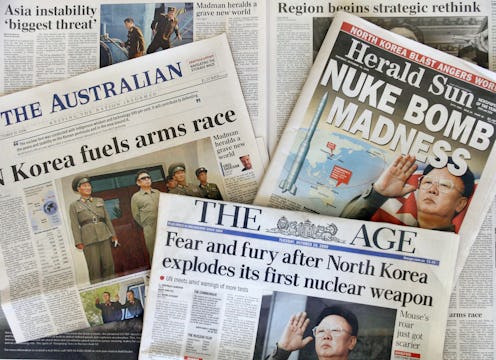
On Friday, Sept. 22, North Korean Minister of Foreign Affairs Ri Yong-ho told reporters in New York his government might soon test a hydrogen bomb over the North Pacific Ocean. This statement was just one in a series of recent violence-infused exchanges between North Korean leaders and Donald Trump, but as tensions mount, it's important to understand the rhetoric. Though both nuclear, hydrogen bombs are more powerful than atom bombs, and the difference lies in an extra step.
Atomic bombs, like the early ones dropped over Japan during WWII, rely on fission. Simply, fission is the splitting of an atom's nucleus to induce an explosion. Hydrogen bombs, sometimes referred to as thermonuclear bombs, use fission, but they also incorporate fusion. When fusion happens, atoms combine into a singular, larger nucleus. When fission is applied to this new "super" nucleus, the explosion is exponentially stronger than with fission alone.
According to Live Science contributor Stephanie Pappas, the atom bomb dropped on Hiroshima "exploded with a yield of 15 kilotons of TNT." However, the first test of a hydrogen bomb in the United States in November 1952 "yielded an explosion on the order of 10,000 kilotons of TNT." The increase in potential devastation between atom bombs and hydrogen bombs is massive.
According to CNN, the North Korean diplomat's statement came just hours after the country's leader, Kim Jong Un, issued an address on state television in which he called President Donald Trump "mentally deranged." As part of the same statement, Kim said he "will surely and definitely tame the mentally deranged U.S. dotard with fire," referring to Trump. He also said that Trump would "pay dearly" for threatening to "totally destroy" North Korea in a speech before the United Nations several days earlier.
Ri followed up with his statements on Saturday, saying in a speech before the UN General Assembly that an attempted rocket strike on the United States is "inevitable." Trump followed up on Twitter that evening:
If [Ri] echoes thoughts of Little Rocket Man, they won't be around much longer!
Whether or not North Korea could actually hit the mainland United States with an intercontinental ballistic missile (ICBM) isn't entirely clear, according to a special report by The New York Times. While the report describes it as "probably possible" insofar as distance is concerned, it's not possible to know whether North Korea could get passed the U.S. antimissile systems. This is because the antimissile systems in place have not been used against a weapon of this caliber during war time. Insofar as tests go, they have been rather successful, though this doesn't necessarily guarantee 100 percent efficacy in the face of a surprise attack.
Unfortunately, the report also says that while North Korean missile aim isn't the best, the precision wouldn't really matter with bombs this strong. They would be unable to target an exact space, but they might be able to hit one area broadly.
There are several other logistics concerned, such as designing a missile that can stand being projected into space and returning, and whether North Korea has gotten that far isn't entirely clear. A video recorded in July seems to show a missile falling apart upon reentry into the earth's atmosphere. But, according to The New York Times, because the video quality is so low, it's not possible to know for sure.
The world is on edge as Kim and Trump continue to provoke each other, calling each other names and throwing around threats of nuclear attacks with seemingly little ease. But, as many unknowns as there are, the steps before and between a possible North Korean ICBM launch are many. Like anything else, escalated potential for conflict isn't simple, and it certainly isn't black and white.